

On this Page
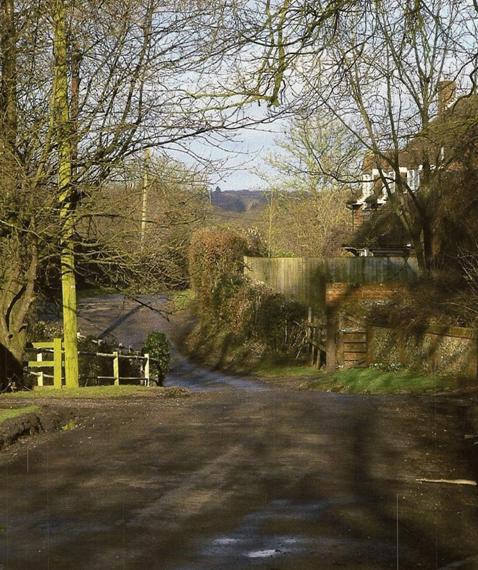
The village of Lacey Green, south-east of Princes Risborough in Buckinghamshire, is situated high in the Chiltern Hills, overlooking the Vale of Aylesbury.
Kiln Lane lies towards the south-eastern outskirts of the village. From its junction with Main Road, this unpretentious lane heads north-eastwards, soon leaving the confines of the village, thence curving down into a deep narrow valley and continuing eastwards, towards Speen.

The coming of the year 2000 was celebrated in Kiln Lane with the burying of a time capsule in the garden of 'Pondside'; also a most enjoyable "Millennium" Party, held in midsummer rather than New Year's Day, in the hope of enjoying good weather. We were indeed blessed by a beautiful day. Everyone was out bright and early for a shared lunch in the field next to "Highwood", which had been kindly loaned for the occasion by Dennis Claydon.
The highlight of the day was a walk down our Lane, led by Dennis. We were fascinated by the stories which he told, and amazed by the amount of information which he had amassed about one small lane. It was generally felt that this should all be recorded for future generations, and after some nagging from me, Dennis agreed to give it a try.
A good deal of further research led to the production of a small book now reproduced here. Co-incidentally, it would appear that the history of Kiln Lane can be traced back for at least the 2000 years whose celebration brought about this production.
I hope that many people will enjoy reading about our very special Lane.
Rosemary Mortham February 2003
Undoubtedly, the oldest feature of Kiln Lane is Grim's Ditch, an ancient earthwork, consisting of an earthen bank and ditch (Seen on the map as an extended ruler that crossed Kiln Lane at the bottom of the hill). The name is derived from folklore, which attributed any mysterious earthwork to the Devil, sometimes known as Grim, hence Grim's Ditch. It can be traced at intervals, for sixteen miles across the Chilterns, running south-west to north-east, from Bradenham to Berkhamsted.
One writer refers to the earthwork as 'a silent serpent of antiquity', its origins being obscure. However, archaeologists generally agree it is of a non-defensive nature, probably a division between upland and lowland pasture or a tribal boundary.
There have been some differences of opinion about the age of the earthwork. Some historians considered it belonged to the Anglo-Saxon era, whilst others favoured an Iron Age origin. In 1992 this controversy was finally resolved. During construction of the A41 bypass, between Tring and the M25, Hertfordshire Archaeological Trust took the opportunity to research twelve sites. As a result, conclusive evidence was discovered which dated the Ditch to the early or middle Iron Age, around 400 BC. This makes the Ditch one of the most important prehistoric works in Buckinghamshire.
Grim's Ditch approaches Lacey Green from the south-east, stopping short at the southern end of the village south of Grymsdyke Manor. After a five hundred-metre break, the earthwork re-emerges again in Kiln Lane, heading in a north-easterly direction, having turned almost at right angles. The Kiln Lane section is located just outside of the curtilage of the village. Lying to the east of the Lane, there is evidence of its course passing through the gardens of two properties and adjacent pastureland. The Ditch continues beside Bridleway L21, which descends steeply into a valley. Crossing Kiln Lane on the valley floor, the earthwork continues north-eastwards, by bridleway and public footpath, en route to Great Hampden crossing Lily Bottom Lane.
This two and a half mile stretch is the longest complete section in the Chilterns.
The Ordnance Survey map reveals the earthwork turning at right angles in Lacey Green and again in the vicinity of Great Hampden. Whether this is due to the lie of the land, or for some other reason, is uncertain. The village of Speen, lying to the south-east, is thus embraced on three sides by the earthwork. This has given rise to a theory that the village may mark the site of an ancient settlement. The theory, however, is very difficult to prove and must remain a matter of conjecture.
Is the gap in Grim's Ditch in Lacey Green genuine?
Did the community of Lacey Green become established in this gap?
Was this an entrance into the inner confines of the earthwork?
If not, can the course of the earthwork be traced, since it is no longer visible on the ground?
In an effort to answer some of these questions a geophysical survey was carried out on two sites in 1999. One site was north of St. John's Primary School, the second just south of Kiln Lane, adjacent to Stocken Farm.
The School survey area produced somewhat negative results. There were some indications of a former structure, plus a number of large pits up to five metres across. The Stocken Farm site, however, was more positive with evidence of an interrupted linear feature, possibly a six metre wide ditch with a bank to the north of this. This ditch aligned with the closest extant sections of Grim's Ditch in Kiln Lane, to the north-east. The results of the survey indicate the monument probably extended at least as far south-west as Main Road. It is suggested, therefore, that the gap is probably a genuine one. Another theory, which cannot be proven, is that the course of the Ditch continued along the present route of Main Road, linking with the section at the southern end of the village.
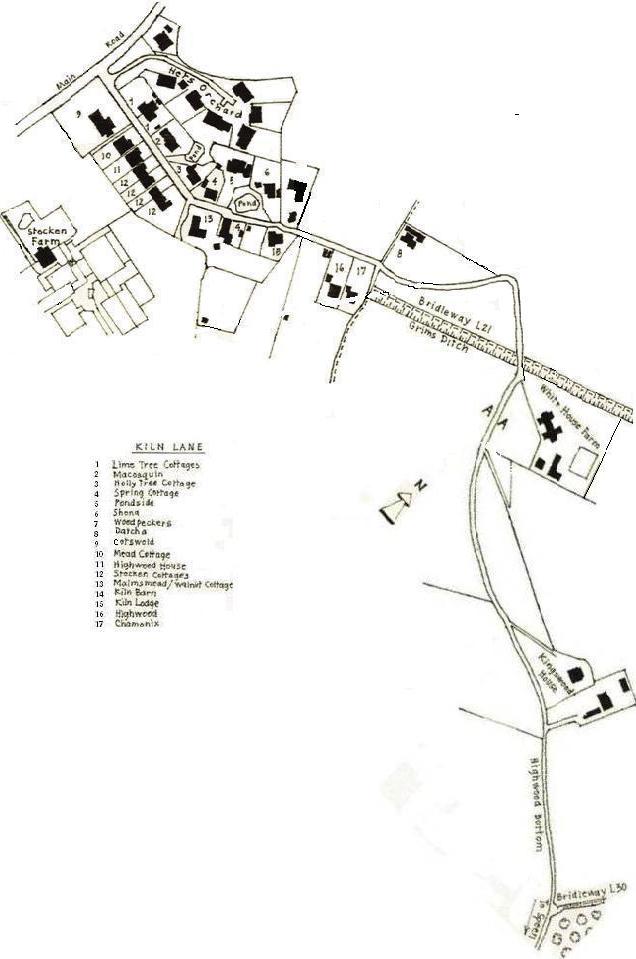
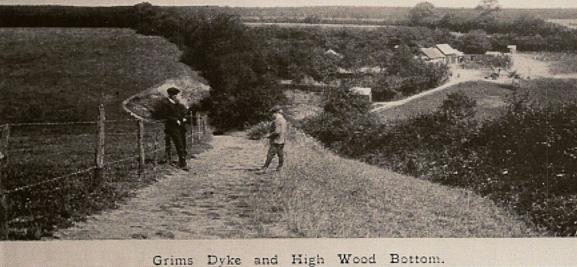
Additional evidence suggests brick making may have played a part in the destruction of the Ditch in the Kiln Lane area. This will be dealt with in the next section. Whatever the purpose of the Ditch, the segments visible today are but a shadow of their former appearance. Indications suggest the project was well planned and the route surveyed. This is evident from the fact that the Ditch lies about half a mile back from the escarpment edge throughout its entire length. It was certainly a massive undertaking and the work of many hands and resources. Perhaps Iron Age man was the first to set foot in 'Kiln Lane'? Other sections of Grim's Ditch occur in Oxfordshire, but it is uncertain if these form part of the same work.
From the dim mists of pre-history, a giant leap forward in time, to the seventeenth and eighteenth centuries. From this period documents and maps first make reference to 'Lacies Green', 'Leasey Green' and 'Lacey's Green'. It is reasonable to assume therefore that the first foundations of the community were being laid at this time.
From the fourteenth century onwards, brick and tile making became an established industry in various parts of the Chilterns. At a far later date, as the name Kiln Lane indicates, brick making came to Lacey Green. Evidence suggests it was possibly in operation for well over a century. Several generations of the Floyd family were engaged as proprietors.
One of the earliest references is to 'John Floyd, Brickmaker', who was buried in Princes Risborough on 1st February 1703, and Hampden Estate Records mention 'Lacey Green Kiln' in the year 1752.
A Joseph Floyd, described as a 'Brickmaker, of Lacey's Green', made his Will on the 11th May 1745. He bequeathed to his wife, Ellinor, property in Loosley Row and Princes Risborough. Sadly, however, he makes no reference to the Brick Kiln. Joseph was buried in Princes Risborough on the 9th December 1756. Ellinor also died before she could take upon herself the execution of the Will. On 8th June 1758, Administration was granted to son, William.
An Indenture, dated 2nd October 1761, refers to 'William Floyd of Lacey's Green, Brickmaker'. He is described as the 'son of and also named in the Will and Testament of Joseph Floyd, late of the same place, Brickmaker'.
William Floyd, distinguished as 'the Elder', made his Will on the 9th May 1801 and died shortly afterwards. He bequeathed property in Speen to his daughter, Mary Stone. His son, also named William, was to receive a legacy of 'sixty pounds of lawful money of Great Britain' (£3.9K in 2025) Provision is made for his three grandchildren, Joseph, Elizabeth and John, the children of his deceased son, John, who had died in 1800, at the age of 51 years, leaving his Widow with three small children, all of whom were under the age of five.
William, Senior, then makes specific reference to the Brick Kiln. William, Junior, and son-in-law Francis Stone are to receive property and land in Loosley Row and Princes Risborough. Additional land includes, 'my garden plott near or adjoining to the Brick Kiln at Lacey's Green', also, 'a small Close or Paddock with the Trees thereon Growing lying near to the said Kiln'.
William, Junior, was buried in Princes Risborough on 31st October 1821. A Widower, the entry in the Princes Risborough Parish Registers describes him as a 'Kiln Man of Lacey's Green, aged 76 years'.
The Hampden Estate Account Books of the Earl of Buckinghamshire refer to a William Floyd supplying bricks and lime to the value of 14s.9d in 1764 (£120 in 2025) for repairs at Green Hailey. Another entry for July 1772 records William Floyd supplying seven hundred and fifty bricks and twenty bushels of lime. These goods, to the value of £1.1 s. 10d (£160 in 2025), were for work at a farm in Hampden Row. This bill, like so many more in the Estate Accounts, was not paid until eight months later. This appears to be a general trend; some bills not being settled until a year later. It seems likely this William Floyd was probably the same William referred to above as 'the Elder'. One wonders if the long wait for the settlement of the account would have had a serious effect on the financial side of the business
In February 1798 Britain had been at war with France for five years. Instructions were issued by the authorities to make returns of all able-bodied males, between fifteen and sixty years. The returns did not include those already serving in a military capacity, but those who could be called upon in case of 'invasion or any other attempt of the enemy upon our coasts'. The whole project took eighteen days from conception to completion. The speed of the operation was no mean feat, even by modern standards.
Complete returns for the Posse Comitatus survive for no county in England or Wales other than Buckinghamshire. The returns for Princes Risborough record a total of three hundred and fifty one men, of these, one hundred and fifty three were from the Upper Hamlets, (i.e. Lacey Green, Loosley Row, Speen).
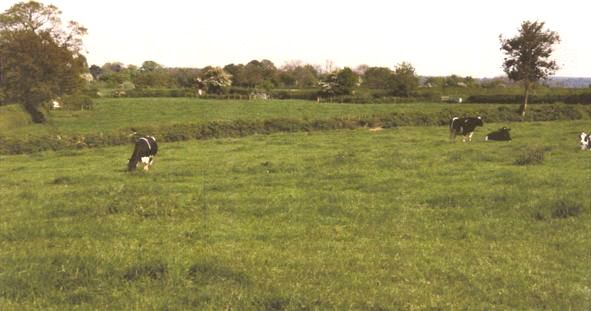
Amongst those recorded in the Upper Hamlets are John Floyd, William Floyd, Senior, and William Floyd, Junior. The returns also record the occupations of those listed therein. The Floyd's, however, are recorded merely as 'Labourers'. Perhaps the art of brick making did not warrant a special category.
The main site of the Kiln is associated with 'Malmsmead', formerly Kiln Farm. The four acres of land then attached to the property, alongside Kiln Lane, constituted the brickwork fields. An Estate map of Lord George Henry Cavendish, dated 1818, indicates that the Kiln once covered a far larger area, extending a considerable distance to the south-east of this site.
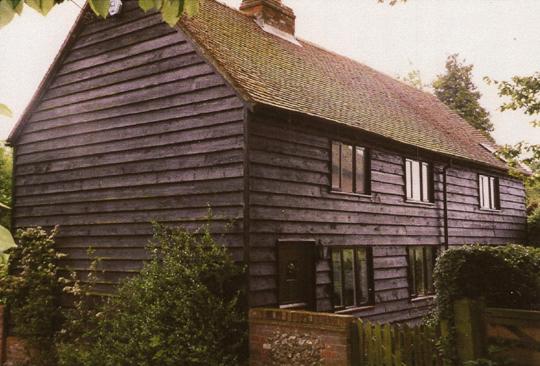
A map in the County Record Office in Aylesbury, surveyed in 1810, but not published until 1820, shows the site connected with 'Malmsmead'. In the early years of the twentieth century, the foundations of a building were discovered in the nearby garden of 'Kiln Cottages', now 'Kiln Barn'. These were assumed to have had some connection with the Kiln. Clearly recorded on the above map are a group of buildings associated with the Kiln, in what is now the garden of 'Highwood'.
Evidence supporting the existence of former buildings was confirmed in the spring of 1999. During building operations on the site, a seam of bricks, tile rubble and a copingstone were unearthed at a depth of about one metre, along the bank forming Grim's Ditch. The bricks were glazed, either on their ends, or along one edge. It is open to argument whether this was the site of the Kiln, or merely rubbish dumped after brick making operations ceased.
Glazed bricks are unusual but not unheard of in Buckinghamshire and were occasionally used for decorative effect on buildings. Perhaps the Lacey Green Kiln specialized in this type of brick.
This also leads to speculation that Grim's Ditch may have suffered mutilation during the time of brick making here. Up to some thirty years ago, in pastureland immediately south-west of 'Highwood', there were two shallow depressions, suggesting clay had been dug at this spot. These supposed 'pits' would again have been made in the line of Grim's Ditch.
It is possible this was the site of the Kiln only in its latter days of operation. In the garden of 'Pondside', to the north of the Lane, fragments of brick have also been found. These, too, revealed signs of glazing. Could this indicate that there were several 'Kiln' sites, over the course of time, within Kiln Lane?
The evidence of a number of possible large pits, located by the geophysical survey on the St. John's School site, is also interesting. This would suggest brick making might once have been in operation some distance to the south-east of Kiln Lane.
A survey of the Parish of Princes Risborough was undertaken in 1808, 1809 and 1810. The purpose was to make an assessment regarding the re-valuation of property for Land Tax purposes. Due to some political quirk, however, the findings were never implemented. Some entries under the heading, 'Princes Risborough Uphill District' are interesting. William Floyd had just over three acres of land, with a house, garden and orchard, valued at £6.8s.0d. Widow Floyd, presumably Sarah, the wife of John, held a little over four acres in her own right. This included a house, garden, Smith's shop and old enclosures. Total values of these were £7.1s.0d (£540 in 2025).
Widow Floyd also has an interest in two other parcels of land. Over sixty acres of land, including a 'homestall' and old enclosure, are entered under her name, as occupier. The proprietor of this property is listed as 'Matthews Esq'. The Brick Kiln and Yard, an area of just over two roods, are valued at £2.0s.0d. The proprietor of the Kiln is John Grubb Esq., Lord of the Manor. Although most of the Floyd property was situated in other parts of the village, this is proof they retained a stake in the Kiln.
Another entry regarding Stephen Clark, (Possibly Clinch. In the transcribed copies of the re-valuation of property for Land Tax purposes, quoted above, Stephen Clark is clearly recorded. However, in the Enclosure Awards, fifteen years later, the corresponding property at Turnip End is awarded to Stephen Clinch, but there is no reference to a house in Kiln Lane.) occupier and proprietor of property in Turnip End, is noteworthy. Additionally, located 'near Lacey Green Brick Kiln', he has a house and garden situated in an area of nineteen perches, valued at £3.0s.0d.
Mrs Floyd is recorded as paying the rates on a house, land and Kiln in the years 1814 and 1815. A further entry states 'Thomas Dell took William Floyd's Kiln Farm from late Buckle Hawes'.
The Land Tax Returns for the 'Upper Hamlets', dated 1820, list John Grubb as the proprietor of the Kiln. The occupiers, who pay the assessment, are recorded as 'late Floyd Executors'.
Discussions were taking place at this time, regarding the Enclosure of the Parish of Princes Risborough. Apart for an obvious death in the family, this may have been a very difficult time for the Floyd's.
From 1801 a Census took place in the Princes Risborough area. This was prior to the nation-wide general registration of 1841, when additional information, such as all names in the household, ages and relationships were required. These early Censuses record only the name of the householder, the number of males and females, ages and occupations of those residing within a household.
In the 1821 Census the household of Joseph Floyd is recorded. This states that two families were living in one household. Two males over the age of twenty years are resident; one engaged in agriculture, the other following a trade. The ages and number of males/females recorded, suggest Joseph's Mother and his younger brother may have been living with him and his family. Other sources record Joseph's occupations as a kilnman, yeoman and shopkeeper. This could indicate the beginning of a decline in the brick making industry for the Floyd's.
The household of Joseph Floyd appears again in the 1831 Census, this time as one family in one house. Joseph is described as a Shopkeeper. Another entry from the same Census records two households, those of Daniel Ridgeley and Samuel Lacey, at the Kiln. Amongst the two families are five males over the age of twenty, all of whom are engaged as agriculture labourers. This may imply either new occupiers at the Kiln, or the return of the land to agricultural use.
The discovery, on the Brick Kiln site, of George III pennies (1760-1820) and a clay pipe, certainly denotes activity of some nature, during the reign of that Monarch.
Common land, in medieval times, provided rights for the peasants. These rights included the removal of wood and stones, grazing of stock and the gathering of fallen fruit. During the twelfth century, lords of the manor began to claim direct ownership of such ground. From the thirteenth century, areas were fenced off in a trend known as enclosure. This practice rapidly escalated during the Eighteenth and Nineteenth centuries.
The survey and valuations of 1808-1810 were probably consulted and taken into account, when the proposal to seek the Enclosure of the Parish of Princes Risborough was first suggested. Following the Royal Assent to the Bill in 1820, another three years were to elapse before the matter finally become reality.
John Grubb of Horsenden, Lord of the Manor of Princes Risborough, was the largest landowner within the Parish. Lord George Cavendish, a non-resident, had recently acquired land in the Parish, making him the second largest landowner. He had a seat in Lancashire, owned an estate in Chesham and was M.P. for Derbyshire.
In June 1819, Pinder Simpson, land agent to Cavendish, but recently established in business on his own account, wrote to Grubb proposing the Enclosure. Grubb consulted with his solicitor friend, Thomas Tindal; both men then sought advice from William Collisson, a land surveyor and agent. Collisson was later to become an Enclosure Commissioner. Terms were finally agreed with Cavendish, following prolonged consultation and negotiations.
Tindal next proposed terms to Richard Holloway, the third largest landowner in the Parish. Holloway, another non--resident, suffered from bouts of illness; therefore time elapsed before a final agreement was reached.
Tindal then informed Thomas Winslow of the intention to enclose, but stated that local consent was needed. Winslow, a resident of long standing and owner of land and property, was fiercely opposed to the proposition. An Opposition Committee was formed, for which Winslow acted as Chairman. At a public meeting, ninety-three people put their signatures to a resolution opposing Enclosure.
The strength of local feeling may have been grossly under estimated. When Henry Hatton, Tindal's Clerk, arrived to post the notice of intent on the Church door in Princes Risborough, he was greeted by a 'tumultuous mob' and 'assaulted'. Five men were arrested. Two more postings were made on the Church door, but special constables were called in to protect the Clerk and keep the peace. At the end of September, a note of intention to oppose, signed by twenty people, was posted on the Church door.
Like their counterparts in the Town, the inhabitants of the 'Upper Hamlets' were also seriously concerned by the proposals. Francis Stone, son-in-law of William Floyd, Senior, objected on the grounds of loss of common rights. Other concerns of resident opponents were: increased Poor Rates, the cost of Enclosure and loyalty to friends.
Ann Dell, with son, Thomas, initially were strongly opposed to Enclosure, signing the opposition resolutions. Thomas owned Speen Farm, whilst Ann had property in Lacey Green. Ann also farmed Stocken Farm, as a tenant of Cavendish, which placed the Dell's in an awkward situation. Was pressure brought to bear? One would assume it probably was, because finally, they would not offer an opinion either for or against.
Sarah Floyd, at the Brick Kiln, openly declared her neutrality, but for this she was bullied and threatened as a tenant. Could this be the reason for the Kiln passing out of the Floyd family? Like-minded traders in the Town were menaced and threatened, some having their property damaged.
The whole project seems to have aroused an atmosphere of mistrust and uncertainty, causing tension and frustration between landowner and tenant alike. After much lobbying, canvassing and counter-campaigning, a Petition was presented in December 1819, the House of Commons giving leave to present a Bill. Other obstacles, however, still had to be overcome, namely the death of King George III and a General Election. Surviving these, after a far from smooth passage, Royal Assent was finally given to the Bill on the thirtieth of June 1820.
This represented a small step forward for the Promoters, but heralded a prolonged period of claim and counter-claim. On the eighth of August 1820, John Grubb, Lord of the Manor, stakes a claim for 'a Messuage or Tenement and Brick Kiln with two closes at Lacey Green in the occupation of Sally Floyd, four acres'.
Francis Stone, acting as Trustee on behalf of John Floyd's children, claims land and property in Loosley Row, plus 'a Tile House and Garden on the Common at Lacey Green'. Ann Dell and Thomas Dell likewise, submitted their respective claims.
Despite the turmoil and emotional upset of the Enclosure, plus the devastating effect on certain individuals, the original document held in the County Record Office makes interesting reading. It records landownership by numbered plots, public and private roads, public footways and bridleways, and public ponds. This document provides the modern local historian with a wealth of information.
The Commissioners nominated and appointed to oversee the Enclosure were William Collisson of Brackley, Northamptonshire, Edward Horwood of Aston Clinton, Buckinghamshire, and Charles Smith of New Windsor, Berkshire. Their task would keep them occupied for a further three years, until the Enclosure was finally concluded on the thirteenth of March 1823.
Kiln Lane can readily be identified from the Enclosure Award Map, described as a 'public Bridleway of the breadth of twelve feet'. It leads 'from the Lacey Green Road at the south-west corner of an allotment to John Grubb Esq., over the south side of the same allotment to the gate leading into High Wood, thence along the north-west side of the same wood to the Parish of Monks Risborough near Iron Beech Kiln'. This, in fact, includes part of the present day Bridleway L21, running towards Lily Bottom.
All the land bordering the northern edge of Kiln Lane was in the ownership of John Grubb. This land, apart from a small area now bounded by Main Road, Idle Corner, the Village Hall and Roundlands, extended eastwards and northwards as far as the Windmill. It consisted of over one hundred acres, in a series of large fields, which Grubb had purchased from the Commissioners. The Windmill, at this time, was considered to be in Loosley Row.
Along the southern boundary of Kiln Lane, land was divided between two owners, Lord Cavendish and Grubb. Cavendish held one hundred and seventeen acres, comprising 'Stockings Farm', in the tenancy of Ann Dell. Grubb had been successful in his claim for the Brick Kiln. He had thus been awarded 'Plot 729', comprising 'Brick-kiln Cottage and Inclosures', totalling a little over four acres. This area was termed as 'Old Inclosures', suggesting they had been enclosed in earlier times. 'Brick-kiln Cottage' was in fact 'Malmsmead', the only dwelling in Kiln Lane at this time.
In hilltop settlements of the Chilterns, a long-standing problem for many generations was the supply of water for cattle and domestic purposes. In long dry summers areas were prone to periods of severe drought. If a community lacked a Parish Well, the only means of supply was water collected from cottage rooftops, stored in underground tanks, or from ponds. A shortage of water at Stokenchurch in the late 1860's, during a period of drought, caused beer to be cheaper than water!
The Enclosure, maybe recognising the problems, made provision for nine Public Ponds within the Parish, (then the Parish of Princes Risborough). One of these was in Longwick, whilst the other eight, perhaps predictably, were in Lacey Green. Loosley Row was fortunate in that it possessed a Parish well, whilst Speen, on the other hand, seemed to manage without either, possibly being able to survive by using private ponds.
Two of these public ponds are situated in Kiln Lane. The smaller of the two lies at the western end of Kiln Lane and is known as Whitewashing Pond. It is described in the Enclosure Award as a 'public pond or watering place ... in an allotment of the said John Grubb containing eighteen perches with a road thereto of the breadth of twenty feet from the Lacey Green Road, including the Public Bridleway No. 1'.
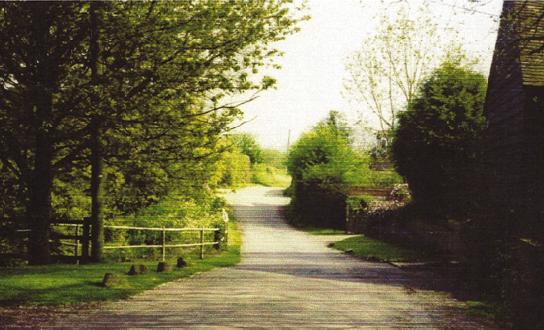
The second pond is situate a few metres to the north-east and is known as Deep Pit Pond. It bears a similar description in the Enclosure Award as Whitewashing, being in the 'same Allotment near the Brick Kiln ... containing twenty four perches'.
The fact that these ponds had a road leading to them 'of the breath of twenty feet' undoubtedly has some bearing on the situation today. Kiln Lane is tarmacadamed as far as Deep Pit Pond, thereafter it is unmade and 'un-adopted'. Residents of the late nineteenth century recall a gate near Deep Pit, for which a toll was payable for passage through, thence leading into 'Public Bridleway No 1', as recorded by the Enclosure Award.
Whitewashing was reserved for cattle and originally there was access to the pond from Kiln Lane. Following on from the Enclosure, administration of the ponds passed to local Parish Councils, at the time of their foundation in 1894, in this case to Princes Risborough. In turn, in 1934, responsibility was transferred to the then newly formed Lacey Green Parish Council. In the 1970's Lacey Green Parish Council sold Whitewashing to a householder in nearby Hets Orchard as additional curtilage. The access from Kiln Lane, which had originally been between 'Macosquin' and 'Holly Tree Cottage', has since been sealed off.
Brick making activities are traditionally said to have been the cause of the creation of Deep Pit. Whilst this theory is a very likely explanation, it is impossible to prove. Known as a 'keeching pond', Deep Pit was reserved for domestic purposes. The water was periodically limed to keep it pure. A small gangplank was erected over the surface, allowing residents to walk out and cast their buckets into the deep. To the two large families resident in the adjacent timber cottages, (now 'Kiln Barn') together with other villagers, this was their only source of water supply. Generations of children have been told this pond is very deep and could be exceptional dangerous if one was unfortunate enough to fall in. Despite this, it was not until the 1930's that it was deemed necessary to erect railings along the roadside edge.
The supply of water to this pond came solely from rainfall and surface water. By a series of roadside ditches, water was drawn from as far afield as Main Road. Around the turn of the twentyeth century the volume of water entering the pond caused it to break its banks and flood the dip in the road alongside. This was a source of joy to the boys of the village, who found great amusement in negotiating the flood with the aid of stilts. Modern road drainage has severely curtailed the former supply of water. Today only surface water and rainfall from the immediate area drains into the pond. It would appear most unlikely that flooding will ever again be a cause for concern. However, a considerable rise in the normal water level has been noted, due to the very heavy and prolonged periods of rain during 2000 and 200l.
About the same time as the flooding early in the twentyeth century a major crisis occurred. The Owner of 'Gracefield', in Main Road, purchased a car, one of the first in the village, which was garaged in the Coach House at Idle Corner. Oil, leaking from this vehicle, found its way into roadside ditches, eventually draining from Idle Corner into Deep Pit Pond, causing severe contamination.
During the summer of 1921 there was a severe drought, water being in very short supply in Lacey Green. Whitewashing was dry, in order to provide water for cattle therefore, a series of journeys, organised on a full time daily basis, were made with a horse drawn water cart, to a source of supply in Saunderton.

Deep Pit, too, although not dry, was very low. A seventeen-year-old youth in 1921 reported entering the pond, descending down to the waters edge. A small amount of water remained in the bottom of the pond. From this position, some indication of the depth of the pond could be gauged. Looking upwards, the roofline apex of the nearby timbered cottages was just visible. Over seventy years later, during conservation work in the 1990's, a depth was recorded of 'under four feet'. This would suggest a certain amount of silting up has taken place during the intervening years.
In the 1920's it was not uncommon to find moorhens and ducks on this pond. No doubt the wild ducks found some attraction in the domestic ducks, which also frequented the water, from their home in the garden opposite the pond. Then, for some inexplicit reason, over a long period of time, these birds seem to have forsaken this pond. Since the late 1990's, however, a return of moorhens and wild ducks has been witnessed, some of which have been successful in raising their broods. The pond has seen the annual migration of frogs, being the source, over several generations, for small boys to catch tadpoles and newts. It has also provided a place of wayside refreshment for badgers and foxes on their nightly wanderings.
With the coming of mains water to the village in 1934 the usefulness of this commodity became redundant. Now under the care of Lacey Green Parish Council, Deep Pit is registered as a Parish Pond, one of only four remaining in the Parish. If they so wish, parishioners may still exercise the right to draw water from this pond!
At the time of the Enclosure, as previously stated, 'Malmsmead' was the only dwelling in Kiln Lane. Even at this stage the building was a mature one, reputedly dating from the seventeenth century. Over the course of time the dwelling has varied between being one main residence or two cottages. It is, today, composed of two cottages, 'Malmsmead' and 'Walnut Cottage', which together form one of the seven listed buildings of special architectural or historic interest in Lacey Green.
The building consists of a seventeenth century bay to the west, rebuilt in brick and flint during the nineteenth century . An early eighteenth century chequered brick range to the east, featuring glazed bricks, with 20th century brick extensions to the north end of the east range. The structure certainly has a long and fascinating history.

Scratched into a brick, on the east side of the building, is the date 1499. This appears rather early to be genuine. It seems likely this is the work of some mischievous youth in times past?
Possibly the earliest surviving records of the building, date from the middle of the nineteenth century. On the 31st December 1855, William Woods, a Miller, of Loosley Row purchased the property from a group of gentlemen residing in Norfolk and Essex. These gentlemen are known to have represented the Mortgagees of the Duke of Buckingham who had become a landowner in the Parish. Could it be that the Duke was the former owner of the property and that these gentlemen were trying to recoup some of their lost assets?
William Woods, who was no doubt working at the Windmill, then known as Loosley Row Windmill, was possibly a tenant of the Duke, for the Duke owned a considerable amount of land to the north-west of Kiln Lane, extending as far as the Windmill. Indeed, it is the Duke who is reputedly credited with having the Windmill removed from Chesham and placed in its present position in 1821. Whether William Woods was a shrewd businessman who had an eye for making a quick "buck" is not known, but after barely two months he sold the property. The Purchaser was Joshua Dell, described as a Timber Dealer, a resident of Lacey Green. Joshua Dell's Father and Grandfather, both named Thomas, had farmed at Speen Farm.
Research reveals that Joshua purchased two cottages and four acres of land situated around the centre of the village in 1838, ( Vine Cottage/Idle Corner, plus land now occupied by the Village Hall and Roundlands.) This property had been in Joshua's family over several generations, dating back to the eighteenth century. In February 1856 he sold all this property to Mary Grace.
By an Indenture dated 8th March 1856 Joshua Dell contracted with William Woods for the purchase of property in Kiln Lane. The property ('Malmsmead') is described thus:
All that messuage or farmhouse and Homestead with the Barn Stable and other outbuildings thereto belonging situate and being at Lacey Green in the parish of Princes Risborough aforesaid And also All that two closes of pasture land adjoining and belonging to said Farmhouse and Homestead called or known by the name of Brick Kiln Closes All which said Farmhouse Homestead Closes and premises contain together by admeasurement four acres and twenty eight perches (be the same more or less) and are part of a farm called 'Kiln Farm' late in the occupation of George Webster and now of William Floyd and which comprise a certain Old Inclosure heretofore belonging to John Grubb Esquire distinguished upon the Map or Plan annexed to the Award of the Commissioners for enclosing the said Parish of Princes Risborough by the Number 729 ....
A right of way is also established to the property,
... particularly a general and unlimited right of road or way with or without horses carts and carriages at all times thereafter over and along so much of a certain road or way leading out of Lacey Green Road ...
The Plans accompanying the 'Abstracts of Title' date from the time of the Enclosure. The earliest of these indicates only the house, not showing any outbuildings. In the vicinity of where 'Highwood' now stands some buildings are indicated, which would have been the site of the Kiln.
The before mentioned report on Grim's Ditch states that in the survey area near Stocken Farm an alignment of positive anomalies may indicate the foundations of a former farm building. It continues by making the point that their orientation is not consistent 'with any of the existing buildings at Stocken Farm.
As these positive anomalies lie towards the north-east corner of the survey area, it is a matter of conjecture whether they could be associated with 'Malmsmead', in the days when it was 'Kiln Farm', rather than with Stocken Farm.
There is a tradition that the nearby timbered building, now known as 'Kiln Barn', once served as the barn and outbuildings to 'Kiln Farm'. There is no positive proof of this; however it is possible that Joshua Dell was perhaps responsible for the erection of this building. Certainly two wooden cottages, with a range of attached farm buildings, existed on the site at the time of his death in 1865.
The 1861 Census records Joshua Dell, a bachelor, living with his younger married sister, Anne, and her family. She was the wife of John Claydon and they had five children, Jabez, Eliza, Mary, Elizabeth and Joseph.
Following his death, Joshua, by his Will, bequeathed his property equally between his two nephews, Jabez and Joseph. Jabez was a young man of twenty-six years of age at the time of his Uncle's death. Joseph, however, was still a minor, an eleven year old school boy, and thus could not officially inherit the Estate until he attained the age of twenty-one years.
Upon reaching the age of majority in 1875, a Plan was drawn up of 'Kiln Farm Cottages', detailing the equal amounts of two acres, thirty-four poles, allotted to each brother. The brothers, accepting their respective portions, under the terms of their late Uncle's Will, signed the Plan. The Vicar of Lacey Green, Reverend William Johnston Burgess and William Ralph Burgess, both of Lacey Green Vicarage, witnessed the signatures, as was the custom of the day.
The Plan clearly indicates that 'Malmsmead' consisted of two cottages at this time. Jabez's portion consisted of 'Malmsmead', together with adjacent meadowland. Also included were some farm buildings, comprising a cow shed and a pigsty. Part of a barn was to be shared with Joseph.
These buildings, on land belonging to 'Malmsmead', have long since disappeared, but were in fact attached to what is now known as 'Kiln Barn'. Joseph's portion consisted of two timbered cottages ('Kiln Barn'), plus an attached range of farm buildings, including the shared barn. In addition he was to receive meadowland, to the north-east, further along Kiln Lane.
It is almost certain that Jabez Claydon availed himself of the occupancy of 'Malmsmead' shortly after gaining his inheritance. In 1867 he married Annie Smith, a young lady of twenty-six years of age, whom he met whilst they were both working at Lacey Green Vicarage.
Annie was born in London, but had spent time working in other parts of the country. However, the couple spent the whole of their married life at 'Malmsmead', then known as 'Kiln House'. During their forty years of marriage it seems likely that Jabez converted the property back into one dwelling.
They had three daughters, Catherine, Susannah and Elizabeth. Catherine was a teacher at Lacey Green School whilst the youngest daughter, Elizabeth, married the Headmaster of the School, Albert Phillips. Catherine, with her husband Owen Biggs emigrated to Australia, where their descendents still reside. Susannah married and lived locally, as some of her descendants continue to do.
A bizarre and rather sad occurrence befell Annie in October 1907. Rising as normal around six in the morning she went about her usual household duties. As the morning progressed she partook of her' elevenses', then, with the aid of her daughter, Elizabeth, began to prepare lunch. Feeling a little unwell and complaining of neuralgia she declined her lunch, retiring upstairs to bed to rest for a short period. Around a quarter to two she arose, went downstairs, requested a cup of tea and proceeded to the backhouse, passing through the kitchen to get there.
On preparing the cup of tea, Elizabeth went to the backhouse to inform her mother, only to find her lying on the floor. The floor onto which Annie had fallen was of brick construction. Elizabeth noticed that her mother had sustained bruises to her forehead and nose. Following assistance it was discovered that Annie was dead and a Doctor was summoned.
The Doctor concluded that Annie had died through shock caused by falling upon the floor. As she had previously been reasonably hale and hearty an Inquest was necessary. The Jury returned a verdict of accidental death. Jabez continued to reside at 'Malmsmead' until his death in 1910.
Following the death of Jabez the property was sold, the purchaser being a Mrs. Hyde of London. Then followed what can only be described as one of the more colourful periods in the history of the building. Mrs. Hyde did not wish to take up residence but decided to let the property, and the exploits of the two young men who took up the tenancy will be revealed in the next chapter.
During the 1920/30's Mrs. Mabel de Selincourt was the owner of the property, then known as 'Lavender Cottage'. Mrs. de Selincourt was either the Mother or the Aunt of Elizabeth Dorothy de Selincourt. In 1913, Dorothy, known as 'Daphne', had married Alan Alexander Milne at St Margaret's, Westminster. Milne had been a young assistant editor of 'Punch'. It was during the course of his work that he met Daphne. Returning from active service after the Great War, Milne found his services at the magazine were no longer required. Encouraged by his wife, he began to write books, poems and plays on his own account.
The birth of a son, Christopher Robin, in 1920, brought much rejoicing. Milne wrote 'Winnie the Pooh' stories and other poems for his son. Again, encouraged by Daphne, these stories were published. It is chiefly because of the 'Winnie the Pooh' and 'Christopher Robin' stories, which have become so popular with children, that Milne is remembered.
Mrs. de Selincourt is known to have had a revolving summerhouse in the large garden at 'Lavender Cottage', in which she spent many hours sunning herself. Another owner of the property was Dr. Charles Fagg, an eminent Physician of Guy's Hospital in London. Mrs Fagg suffered with ill health, but was fortunate enough to have a 'live in' resident nurse. The couple had two children, a son, who followed in his Father's footsteps as a Doctor, and a daughter, Beatrice, who remained in the village for the remainder of her life.
Bessie Currell, the daughter of George Currell of Lime Tree Cottages, Kiln Lane, was employed in the Fagg household. Bessie's niece, Daphne Bristow, a young girl living in the village, suffered an accident in the garden of her home. On admission to hospital in Aylesbury, it was found she had broken her arm at the elbow joint.
At the instigation of Dr. Fagg she was transferred to Guy's Hospital. Unfortunately, whilst there she fell from a wheelchair, breaking the same joint again, thus necessitating several months stay in hospital. By a strange coincidence, at the same time, Daphne's father was diagnosed with appendicitis. The cure for this was still in its infancy, thus the condition was considered to be of a fairly serious nature. Once again Dr. Fagg arranged for the patient to be admitted to Guy's Hospital, where the treatment provided proved to be a complete success. For a short time father and daughter were in adjoining wards. Daphne, at the time, a pretty blonde haired child, recalls that Dr. Fagg always addressed her as 'Flower'. Sometimes he would allow her to accompany him as he toured the wards.
Another recollection is of the Fagg's nurse taking Daphne and her sister on a walk to Lacey Green Windmill. The owner of the Windmill must have been friendly with the nurse, for the party were provided with tea before the return journey.
The next Purchaser was Mr Arnold S. Clark, a London businessman in the glass industry. Mr Clark moved his wife, Zettie, and young family, to 'Lavender Cottage', following the evacuation of London in 1939. A distinguished Baptist Local Preacher, it was whilst resident at 'Lavender Cottage' that Mr Clark first established his long association of almost forty years with Lacey Green Methodist Church and Loosley Row Baptist Church.
Regularly supplying the pulpits of each respective Church, he is known to have delivered approximately one thousand two hundred sermons in Lacey Green Methodist Church, probably the greatest number of sermons ever delivered by one man in that Church. For more than a quarter of a century he conducted a combined Christmas Day service between the two Churches, held alternately in each Church. Both Churches closed in 2001.
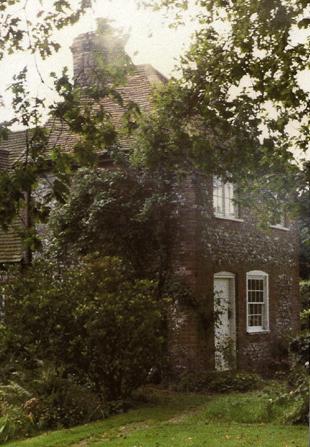
In 1942 Mr Clark moved to nearby Parslow's Hillock and 'Lavender Cottage' was purchased by the Misses Helen Mary and Kathleen Sampson. The situation of the property at the time is described as 'approached from a quiet lane on the outskirts of a hill-top Village, amid rural surroundings but handy for the Village amenities'. Obviously only one dwelling at this time, the accommodation comprised Verandah, Lounge Hall, Lounge, Study, Lobby, Kitchen, Large Larder, five Bedrooms and a Bathroom.
The grounds consisted of' a pretty ornamental garden with brick paths, fine trees and shrubs, tennis lawn, large well planted kitchen garden, greenhouse, small orchard and a paddock, in all about two and a half acres'. Probably this description of the grounds attracted the two maiden sisters to the property, for they were very keen gardeners.
Renaming the property 'Malmsmead', the retired schoolteachers spent numerous happy hours, for well over thirty years, tending and nurturing many exotic and unusual plants in the gardens. They cultivated a vine, which produced some fine grapes. Kathleen was also an enthusiastic beekeeper. Following the death of Helen Sampson, the house was once again converted back into two dwellings, the western end of the building forming the conversion, hence its renaming 'Malmsmead West'.
When Kathleen Sampson died in 1980, the property and adjacent meadowland, which from the days of Jabez Claydon had remained intact, was divided up. 'Malmsmead West', with a sitting tenant, remained as part of the Estate of Miss Sampson. 'Malmsmead' and the meadowland were offered for sale by auction in two Lots.
Mr. and Mrs. Michael Piercy purchased the house and R. M. West and Son of Stocken Farm acquired the meadowland. Several years elapsed before 'Malmsmead West' was finally sold. The property was brought by Mr. R. Davidson and renamed 'Walnut Cottage'.
The year 1913 proved to be an eventful one, both nationally and locally. It was the third year of King George V's reign and Herbert Asquith, the last Prime Minister to preside over an exclusively Liberal government, had been in power for five years. The burning issue of the day was 'Votes for Women'. During the spring, Emmeline Pankhurst, the leader of the campaign, was jailed for three years. A drama occurred in the summer, when thirty-eight year old Emily Davidson, another campaigner, ran onto the track at the Epsom Derby and seized the reins of King George V's horse. She received fatal injuries when the horse trampled her.
Locally, the Organ in Penn Parish Church and Saunderton Railway Station became victims of arson attacks to draw attention to the cause. Saunderton Station was to figure largely in the news for another reason before the year was through.
In Kiln Lane, the two young tenants of 'Malmsmead' were beginning to establish themselves. William Weatherill, aged twenty-two years, and Alfred Tragheim, aged twenty-one years, had viewed the property and considered it would be ideal for their needs. The new tenants readily agreed with the owner, Mrs. Hyde, who wished to let the property as furnished accommodation, to retain the gardener and housekeeper, so that the house and grounds might be cared for in a proper manner. To allay any anxiety that Mrs. Hyde may have had in letting to persons of such tender years, three months rent was paid in advance.
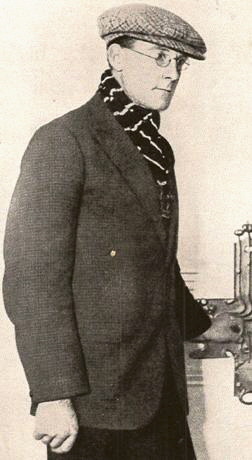
Weatherill, writing in later years, gives his readers a pen picture of Lacey Green and the house thus:
Lacey Green itself lies in beautiful country about two miles from Saunderton Station on the Great Western Railway to Aylesbury, and about three and a half miles from Princes Risborough and West Wycombe. We wanted a place where we would be absolutely secluded yet within easy working reach of London.
The house itself was an old-fashioned little affair standing in a few acres of its own grounds and well away from the beaten track. Let the reader visualize a stone-paved study and parlour, one of those great open fireplaces and ingle-nooks supported by ancient oak beams. It was picturesque, low ceilinged, but very draughty.
Everything about the place reeked of times gone by. It had a serving maid's kitchen over the top of a deep well with a pump in the corner, a dark little buttery, a narrow winding staircase leading to half a dozen quaint little bedrooms, and half-panelled walls dating back to the seventeenth century. But it suited us well.
These two polite, fashionable and smartly dressed young men purported to be medical students whose work frequently took them to London. To reach the Station from Lacey Green involved a two and a half mile walk, from Kiln Lane around Church Lane, then using the footpath to Small Dean Lane, finally continuing by Small Dean Lane to the Station.
The two young men could be observed leaving for their trips to London, smartly suited, wearing bowler hats, carrying rolled umbrellas and attache-cases. The villagers regarded them as two harum-scarum students who lived the 'high' life, for they would occasionally hire a car from Princes Risborough. The housekeeper, a local girl, Mary 'Polly' Claydon, was barred from the front bedroom at the western end of the house. This room was always kept locked, but she thought nothing of this, assuming the room was reserved for medical experiments.
The above picture of two high-class medical students, could not, in fact, have been farther from the truth. These young gentlemen had set up their headquarters in Kiln Lane, the nerve centre of operations for 'Smithson and Sikes', expert burglars and housebreakers. Weatherill, alias Frank Watson and Tragheim, alias Alfred Carlton, had served Borstal sentences and both had just been released prior to their arrival in Lacey Green.
Finally, in a place of their own, the two could sit down quietly in the evening, with the dimly burning oil lamp as means of illumination, to work out their schemes for the future. Here, unseen, unheard, unmolested and in splendid isolation, they set about their plans to raid a series of large country houses nationwide.
Their first exploit from Lacey Green was to a country mansion near Warwick, which provided 'rich pickings'. On another occasion plans were made to visit the Duke of Bedford's estate at Woburn Abbey, but this mission was aborted when they were spotted and chased by security guards. However, not being deterred, they relieved a gentleman farmer, in an adjoining village, of cash and jewellery. Making good their escape on an old bicycle and a horse belonging to the farmer, which they abandoned near Biggleswade, they visited the nearby home of a Bedfordshire brewer. Following another successful 'haul', they continued to Bedford, where they breakfasted, washed and brushed up, then caught the train back to London and thus Lacey Green after an eventful night's work. Another campaign of burglary took place in the counties of Gloucestershire and Worcestershire.
All these expeditions were carried out by means of train travel, walking from Lacey Green to Saunderton Station, travelling to London and from thence to the desired destination. A couple of first-class quarterly season tickets were purchased for the journey from Saunderton to London. To avoid detection if plans when wrong, these tickets were placed in a safe deposit before taking a train from London to carry out burglaries. All the proceeds from these burglaries had to be transported from Saunderton Station to Lacey Green on foot, hidden in attache cases.
The series of burglaries attracted the attention of Scotland Yard and police were alerted nationwide. It was said the Scotland Yard men would have been amazed if they could have seen the pair setting out from Lacey Green with their burglars' outfits. Tools, keys, maps, a rope ladder, a railway guide, gloves and masks, even their supper, were all hidden from sight in large attache-cases. Indeed, it was reported that the local police constable would have received immediate promotion to sergeant had he known two such wanted men were living on his doorstep.
After this series of 'successful' exploits, the pair considered they had earned a holiday. The results of their labours had produced sufficient to allow a good living rate of £25 per week (that's £2.5k in 2025), plus an excellent wardrobe. However, on the downside, a conglomeration of un-saleable stolen property was amassed, which was deposited in the locked bedroom. Alfred Carlton, who was a Scotsman, decided he would like to visit his family in Edinburgh, so the pair set off first-class from Kings Cross, travelling northwards in style.
Following a most unwelcome reception from Carlton's family, the pair toured Edinburgh. On their wanderings they hatched a plan to steal the crown jewels of Scotland, housed in the jewel room of Edinburgh Castle. The scene was inspected and a conclusion reached that the robbery might involve a certain amount of violence, in order to overcome the guard. A week was spent in researching the situation, before the pair returned to deepest Buckinghamshire to make their plans.
Back in Kiln Lane, it was decided that Carlton would use chloroform to disarm the guard, whilst this was in progress Watson would set about obtaining the jewels from the case. To this end Carlton, who fancied himself somewhat as a scientist, began some experiments to test his skills. As a result of his efforts the family cat and two tame mice succumbed to his deadly concoctions, whilst the poor unsuspecting housekeeper was lucky to escape with her life! Little thought was given to the sheer foolishness of the robbery, or if successful, the un-saleable items which would be obtained.
In the event the whole episode turned into a farce. The pair returned to Scotland, intent on putting the plan into action. They selected a dark, wet, foggy day, when there would be few visitors. Entering the jewel room, Carlton fumbled with the chloroform, but instead of administering it to the guard; he succeeded only in dropping the bottle, which broke upon the floor. This caused a terrible smell, which raised the suspicions of the guard. Luckily for them, however, the guard thought they were only playful students making themselves a nuisance and requested them to leave, otherwise they would have been in serious trouble.
In the early days of his 'career', Watson had taken to carrying a revolver around with him, an act that he grew to regret. He would even sleep with a pistol under his pillow in his bedroom at Lacey Green. This arose from the idea that the pair might be tackled by the police at any time and would have to fight for their lives.
The long trail of crime committed by these two young men came to an abrupt termination in Kent. Following successful 'operations' in that County, the pair selected a number of promising looking properties, which they proposed to revisit.
One evening in late spring, a few days after their previous visit, they arrived at Penshurst Station, on the last train, attired as prosperous City gents. They were the only passengers to alight, and in retrospect, arriving at a quiet village Station at such a late hour, was rather a foolish move. The ticket collector, who in the ordinary course of events would have known everyone, cleverly took no heed of the two strangers, but, being an observant fellow, his suspicions were aroused, knowing as he did of the recent burglaries in the area. Immediately the pair had left the Station the ticket collector contacted the police. Watson and Carlton set off for their night's work, blissfully unaware of the events that were to befall them.
The first house they visited was the home of a Lord, but he was away abroad. The house being particularly well secured, the project was quickly abandoned. The second house proved to be that of a Canon, however, there was no sign of great wealth and only a few shillings were realised in this exercise.
A move was made across the road to the home of the Chairman of the Thames Ironworks. Here, after a struggle to gain entry, fortune smiled upon them. Once inside they had the free run of the house. All the downstairs reception rooms were systematically ransacked before moving upstairs to the bedrooms. In one of the bedrooms they found the family jewels, such a haul they had been searching for from the beginning.
There were diamond and ruby pendants, tiaras, bracelets, necklets, rings and watches, together with a host of other glittering articles of a women's personal jewellery. By a strange twist of fate it later transpired that this jewellery had only been removed from the safe that day, because workmen were undertaking repairs to the room where the safe was housed.
Well pleased with the night's work, the couple had the cheek to return to the Canon's residence, to 'wash and bush up', before their return to London and thence Lacey Green. By the time this task was completed dawn had broken; finding the most convenient Station for their return to London to be Ashurst, they set off in that direction.
On the way to Ashurst Station a cyclist, who eyed them in a keen fashion, passed the couple, but the pair paid little attention to him. It later proved to be that this was just one of a number of plain-clothes policemen searching the countryside for them. On arrival at the Station, Watson ordered two tickets for London, but before these could be obtained, a gentleman tapped him on the shoulder, requesting him to step into the waiting room for a minute.
The man, who was quickly followed by two colleagues, explained that they were police officers with instructions to stop and interrogate all strangers, following a number of burglaries in the district. Being reluctant to give their names and addresses, or to disclose the contents of their baggage, the pair were forced to await the arrival of the Superintendent of Police from Tonbridge. The London bound train arrived and departed; as both men racked their brains for a means of escape, it became increasingly obvious that the game was finally up. Carlton asked for a drink of water and a police officer was despatched to obtain one. As the policeman departed, Watson opened his bag and produced a loaded revolver. Just at that moment the policeman returned with the water, but seeing the revolver dropped the water and flung himself on Watson, who, following a struggle was quickly disarmed. In the ensuing chaos Carlton made a blind dash from the platform and fled, making his way up the road for a mile or two, however, once Watson had been rendered harmless, the police were quickly on his track and he was soon recaptured.
Once the Superintendent arrived he examined the couple's bags, informing them they would have to accompany him to Tonbridge to explain the presence of the innumerable valuable articles found therein. The pair usually left their railway passes in London when out 'working', however, on this occasion they happen to be carrying them, thus disclosing not only their destination, Saunderton Station, but also their names and the address of their 'hideaway' in Kiln Lane, Lacey Green.
Buckinghamshire police were soon advised of the events and lost no time in raiding 'Malmsmead'. The police forced entry to the house, much to the trepidation of the housekeeper, via a ladder to the front upstairs bedroom window, the locked bedroom - where they discovered a considerable amount of stolen property. A police spokesman commented that a cartload of stuff had been found at 'Malmsmead', the house being like a marine store dealer's.
In their possession on that late spring morning they had jewellery estimated to value £6000. (Over £600K in 2025) After several months investigation into other crimes nationwide, the pair appeared at Maidstone, where they were sentenced, after pleading guilty. Charlton was given four and a half years penal servitude, and Watson, the perceived mastermind, and as the elder man, who should have known better, five years.
It was during the nineteenth century that 'Malmsmead', after standing alone for possibly two hundred years, began to be joined by other dwellings in Kiln Lane. As stated above, certainly by 1875, but probably much earlier, the two timbered cottages next door to 'Malmsmead' were in existence. These small cottages, of the 'two up, two down' type, seemed to have housed large families, even well into the twentieth century.
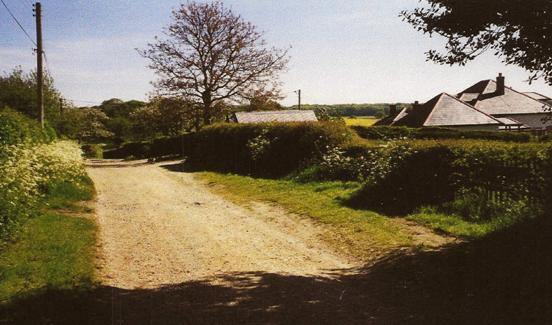
Amongst the families resident at various times were the Smith's, Hussey's, Baker's, Rixon's and Claydon's. The late Harry Floyd, a native of Lacey Green, was born at the beginning of the twentieth century and in his latter days became a resident of Kiln Lane. In his youth he could recall the two cottages being occupied by a total of at least twenty people. As he remarked, speaking at the end of the twentieth century, that by contrast, the building has since been enlarged, converted into one dwelling and now houses only two persons!
One house, which could be accessed from Idle Corner or Kiln Lane, was 'Hets Loo'. Initially a small cottage, dating from the late eighteenth century, the only means of access was via Idle Corner. However, various owners, over the years, have extended the property. Also, a sizeable amount of land has been purchased to extend the garden and create an orchard, allowing an entrance to be made from Kiln Lane.
There was a tradition, handed down by word of mouth, that the original cottage was the oldest building in the village, but no evidence has yet been found to substantiate this claim. During the early years of the twentieth century members of the De Beer family, famous for their diamond mining, occupied the property. The family, of Dutch origin, probably named the house 'Hets Loo', either after the Royal residence of that name in the Netherlands or from their estates in South Africa.
The entrance drive from Kiln Lane, immediately adjacent to the Main Road, followed the present course of the private drive into 'Hets Orchard'. At the entrance stood two brick piers, supporting wooden gates, which had been produced from ship's timbers. A very small plaque recorded the ship's name and its home port of Bristol.
A tall hedge surrounded the land facing Main Road. In springtime the Orchard was a mass of daffodils. A 'wartime' baby of the Second World War was evacuated from Essex to Kiln Lane. In the years following, as a very young girl, holidays were spent in Kiln Lane. One lasting memory of that time is the daffodils in the orchard of 'Hets Loo'. The house was demolished in the early 1970's to make way for a development of six properties, known as 'Hets Orchard', with access onto Kiln Lane.
Lime Tree Cottages, two semi-detached dwellings, erected in the traditional 'brick and flint' of the Chilterns, date from the latter end of the nineteenth century. They were originally in the ownership of the Ward family of Loosley Row. Both properties later passed into the Currell family. Free Currell and his wife, Elizabeth Jane, occupied one cottage. Their son, William John Currell, aged twenty years, a Private in the 2nd Battalion, Royal Warwickshire Regiment, gave his life for his Country on 30th July 1917. Their daughter, Elsie Mabel, continued to live in the cottage for the whole of her eighty-two years.
Lime Tree Cottages circa 1915
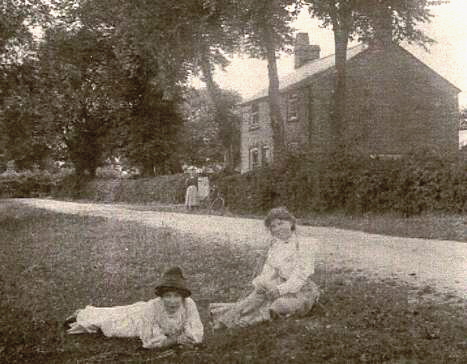
Lime Tree Cottages 2002
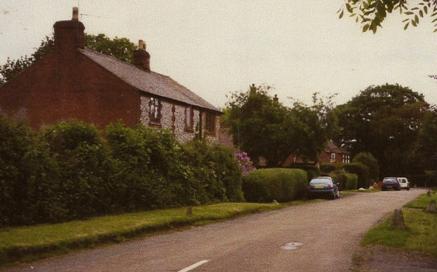
Next door was George Currell and his wife, Mary. Both were ardent supporters of Lacey Green Methodist Church. They too, had a son, Charlie Currell, aged thirty-one, a Private in 2nd/1st Bucks Battalion, Oxford and Bucks Light Infantry, who was killed in action on 2nd April 1917. Mary was amongst the ladies of the village who pursued the art of Buckinghamshire lace making. George kept ducks, which found their way into Whitewashing pond, at the end of the garden.
Another cottage of similar vintage to Lime Tree Cottages lies to the north-east, a little farther down the Lane. Towards the end of the nineteenth century 'Kiln Hill Cottage' was in the ownership of a Mrs Buckmaster of Dunstable, Bedfordshire. This name crops up from time to time within the village, suggesting that this lady was perhaps a 'property developer' of the era.
From eyewitness reports, by the early years of the twentieth century 'Kiln Hill Cottage' had fallen into disrepair and become semi-derelict. Horses from the neighbouring field were said to enter looking for shelter, and the 1901 Census listed it as 'Not in occupation'. It was following this period that the cottage came into the hands of Frederick Rogers, who restored the property. By word of mouth Frederick Rogers is said to have been a 'builder'. However, the 1901 Census records a Frederick Rogers, described as a bricklayer, with his wife and seven month old baby daughter, lodging at 'The Whip'.
Almost half a century ago, when yet more new owners were once again restoring the property, they made a surprising discovery. Removing wallpaper from an interior wall it was discovered a doorway had been covered over at sometime in the past. In fact, the door was still intact and contained a pencilled message to the new owners! The message read:
To the persons who takes this door down. This house was built by Mr Oaldey about forty-five years ago, he was a shoe maker, this was his shop. Afterwards it came into the Chesher family (or Buckmaster), then a Mrs Sheldon of Risboro brought it. Then I bought it (F. Rogers 1893) built the room out, put in a bay window, put in boarded floors, put in a new grate. Built skullery and shop, planted apple trees, planted hedge, fixed glass. I am 33 years old. I might be gone on before when you read this. JS dated Feb 1910.
If you are not saved do get right with God at once for life is uncertain and death is shure Friend
God bless you F Rogers
The door, of boarded construction, had been painted or varnished. After so many years the surface had begun to chip, making some of the lettering difficult to read. However, the above is a reasonably accurate transcription.
Unfortunately, Frederick Rogers omitted to record the date he purchased the property or when the message was written on the hidden door. However, research reveals that he died in 1952, at the age of seventy-three, and is buried in the Lacey Green Methodist Cemetery. This would suggest his birth was about 1879, yet the Census records him as twenty-four years of age in 1901.
If this were correct his birth would have been in 1877. If the message was therefore written at thirty-three years of age, then the year would have been 1910, or thereabouts. The message states the property was built 'about forty-five years ago', which would thus date the building back to around 1865. The Valuation Survey of 1910 records Frederick Rogers as the owner of the property, but James Lacey was in occupation as a tenant at that time. This fact may account for the strange statement above, 'JS dated Feb 1910'. In the old fashioned handwriting, an 'S' could well be mistaken for an 'L'. Exactly what this statement is meant to convey must remain a mystery!
As one progresses north-eastward down Kiln Lane the tarmacadam surface ceases, giving way to an unmade surface. This gravel section extends for a very short distance, before two public footpaths cross it, one leading north-westwards to Goodacres Lane, the other south-eastward, to Turnip End and Speen. To the inhabitants of Kiln Lane, half a century or more ago, this crossing point marked the end of Kiln Lane. Beyond this point the road narrows considerably and was always referred to as the 'horse road' or 'cart road', marking the beginning of Highwood Bottom. Officially today, White House Farm and Kingswood House are situated in Kiln Lane, but evidence suggests this was not always so.
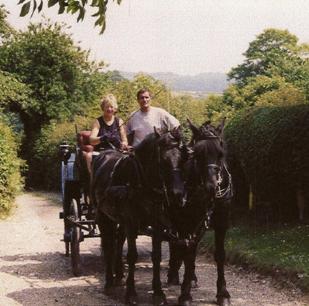
Trade Directories of the nineteenth and twentieth century refer to the inhabitants of Sunnybank Farm, (now White House Farm) as residing in 'Highwood Bottom, Speen'. Likewise, however, the same directories list Kingswood Farm, (now Kingswood House) as Lacey Green! The problem was compounded in the 1970's when the Parish Council was obliged to erect name plates to every road in the Parish. A shortage of cash led to a shortage of signs, Kiln Lane at this time being 'extended' to reach as far as Kingswood House.
Once the road crosses the aforementioned footpaths, it curves sharply and steeply, down into a steep sided narrow valley. At the entrance to White House Farm the road continues along the valley floor, running roughly eastwards, towards the village of Speen. This section, from White House Farm onwards, represents the last remaining section of an important ancient road. Certainly in use during the 18th century, it once formed part of what is now a 'lost' highway, the main road from Speen to Princes Risborough, bypassing Lacey Green.
The remaining section of this road runs along the valley floor, emerging onto the modern day road to Speen at Flowers Bottom, causing a 'hair pin bend', known locally as the 'Devil's Elbow'. This is a fine example of the creation of a 'hair pin bend', the old road being abandoned, whilst a new route turns sharply away, via Flowers Bottom and Darvills Hill, to Lacey Green.
According to the Land Survey of Princes Risborough Parish, mentioned earlier, produced in 1810, much of this section of road was once surrounded by woodland. Proceeding down the steep road from Speen, woodland existed to the west, known as Darvills Hill Wood. On reaching the valley floor, High Wood, also known as King's Wood, existed to the east and north of the road, extending as far as the eastern boundary of the present day Public Bridleway L21.
From the point adjacent to White House Farm the course of the road, now lost, once headed roughly north-westwards, to the present day site of Widmer Farm. Crossing what is now Pink Road, the track curved slightly northwards to emerge into Wardrobes Lane, thence by Brimmers Lane to Princes Risborough. Evidence of this road branching off from Wardrobes Lane may still be seen, sadly however, it is no longer a public right of way.
Over the centuries the course of this 'bypass' changed several times. Following the demise of the route into Wardrobes Lane, a new way was established which passed to the rear of the Windmill, crossing the fields to connect with the present road at White House Farm. When this route, in turn, became redundant, a road, following approximately the line of Goodacres Lane, then crossing the fields to White House Farm, was made. These alternative routes have also long disappeared, leaving this section from White House Farm to the 'Devil's Elbow' at Flowers Bottom as the only portion of the 'lost' road to survive. The present course of the road, curving steeply up from White House Farm into the village of Lacey Green, via Kiln Lane, appears to have only come into being around one hundred and fifty years ago.
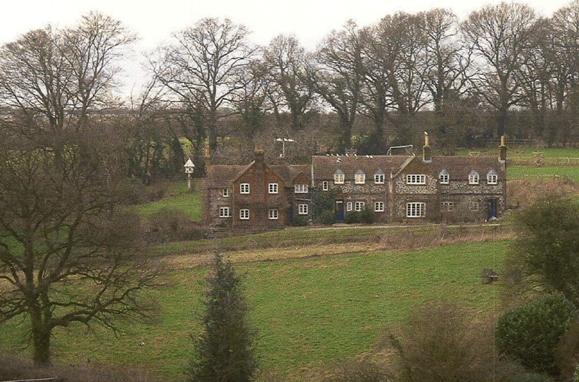
From 1849 to 1855 the site of White House Farm (formerly Sunnybank Farm) and surrounding land were under an ever-changing succession of owners. These gentlemen were, or represented the Mortgagees of the Duke of Buckingham, a one time local landowner, who were trying to recoup some of their losses.
In 1853 there was an auction of seventy plots of land in Speen, some of which were purchased by Sir William Foster (Bart) of Norwich. Some of this land consisted of woodland, which under the terms of the sale, had to be cleared of timber by a certain date. It seems likely that Sir William had plans to sell off much of this land, into smaller plots for development and create new roads.
He sold six acres to John Janes, a Sawyer of Loosley Row, in June of 1855, for the sum of £108. The plot was bordered on the west by an "intended new road", the present day Public Bridleway L21. To the north and west the land was bounded by other property of Sir William's and on the south "by a road lately set out leading from Speen to Lacey Green". Other nearby land belonged to Charles Brown of Stocken Farm, Lacey Green.
Presumably John Janes arranged for the erection of a house and outbuildings, possibly changing his occupation from Sawyer to that of Farmer. Following the Conveyance of freehold purchase, John was freed from copyhold right to timber for members of the Manor.
For ninety-three years the property was to remain in the Janes family. On the death of John, the property was inherited by his wife, Elizabeth, followed by daughter, Caroline, who had married a cousin, Boaz Janes. In September 1892 Caroline and Boaz renewed a Mortgage on two plots of land, one plot comprising six acres, a house, barn and outbuildings known as Sunnybank Farm.
Boaz managed to make a living from a few milking cows, rearing calves, poultry and the produce of an orchard, although he was also known to have been a Benchman in the chair making trade. One of the highlights of his year was his annual visit to Royal Ascot. Caroline, who was probably 'financial administrator', did not wholly approve of this annual outing. However, a neatly dressed figure was always visible during Ascot week, making his way on foot to Princes Risborough Station, en route to the Races.
Caroline and Boaz had a large family, the eldest of whom was daughter Mabel, born in 1887. As a small child, Mabel could recall observing men removing stumps and roots of trees from land adjacent to her home, the last remnants from the site of the former woodland. In October 1904 Mabel commenced teaching at Lacey Green Church of England School, a position she was to occupy until her retirement in 1947. During this time generations of village boys and girls passed through her class, many of whom still remember her with mixed emotions.
An incident, involving Mabel, occurred in Kiln Lane during the dark days of the Second World War. Returning home one evening as the light was failing, she witnessed a number of aircraft dropping personnel by parachute. These men were landing in the field to the north-we of her home. As the aircraft droned away into the distance, Mabel felt very uncertain what course of action to take, not knowing if the parachutists were 'friend' or 'foe'.
Feeling disinclined to venture down the narrow lane to her house on her own, she went to a nearby neighbour to seek assistance. In due course it was established that the parachutists were American troops, who were obviously not where they were intended to be.
Mabel, a single lady, was to have a long retirement following her departure from schoolwork. She died in 1987, just days short of her one-hundredth birthday. In 1948, following the long 'reign' of the Janes family, Doris Oliver, wife of Andrew Oliver, purchased the property. A leading authority on marquetry, Andrew was the Works Manager of a Company in High Wycombe specialising in this craft. The Oliver's, with their young family, remained at Sunnybank Farm for two years, before moving into Church Lane, Lacey Green. Ironically, in later years, they moved back to Kiln Lane, which is still the family home.
The next purchaser of the property was Margaret Haynes-Dixon, perhaps better known as the authoress Rumer Godden. A prolific and successful writer of novels, poetry and children's works, several of her novels being made into films. Amongst her best known works is 'Black Narcissus', much of which was written whilst she was resident at Sunnybank Farm.
Following the departure, in 1952, of the lady with a distinguished literary career, the next purchaser was a gentleman with a distinguished military career, Major General Sir Colin Gubbins and his wife, Lady Anna. Sunnybank Farm, which became White House Farm around this time, was to be the 'hideaway' retirement home of Sir Colin, where he kept a low profile.
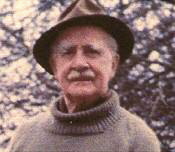
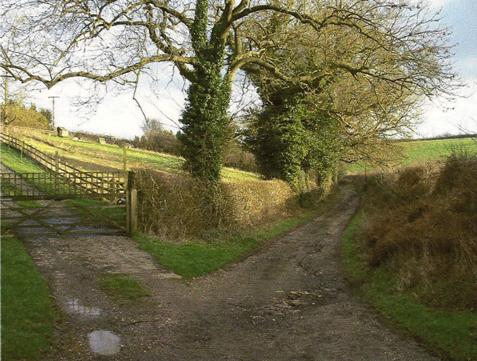
In the early days of the Second World War, Sir Colin established the secret underground resistance movement in Britain, poised to act in the event of a German invasion. Later, acting as Director of Operations and Training at Special Operations Executive, he was given full responsibility for secret missions to Western Europe. Finally, in 1943, he was appointed head of Special Operations Executive.
There are rumours, which sadly cannot be confirmed, that Kiln Lane and White House Farm in particular, has been honoured by two royal visits. During a bout of illness Sir Colin reputedly received a private visit from Her Majesty, the late Queen Elizabeth, the Queen Mother.
A later owner of White House Farm, who kept horses, claimed a visit was made by the Princess Royal, Princess Anne, to negotiate the possible purchase of a horse. From the various sources of these rumours it is envisaged the former is probably true, whilst the latter is somewhat questionable.
Sir Colin and Lady Anna enjoyed the delights of this idyllic, but isolated abode for several years. Following Sir Colin's death, Lady Anna remained at White House Farm until 1975, before leaving the district.
Several more owners followed the demise of the Gubbin's. Over the course of the years, with each successive owner, the property has been enlarged, extended and modify, until it is now unrecognisable as the small brick and flint cottage, with timbered outbuildings, established by John Janes in 1855.
Research has failed to establish with any degree of certainty the original owners of Kingswood House, (formerly Kingswood Farm). However, there is no doubt that Kingswood Farm, consisting of some fifty acres, was built around the same time as its near neighbour, Sunnybank Farm, in 1855.
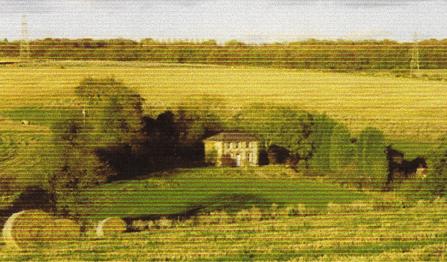
The Farmhouse is constructed of brick and flint. Formerly, a short distance to the east of the dwelling, stood a range of farm buildings, consisting of stables, barn and milking parlour, arranged around a yard. These buildings have all but disappeared, only the shell of the milking parlour remaining. An internal beam of the barn had the date '1855' carved upon it, followed with an inscription, 'Ward, Carpenters, Speen'.
Sir William Foster's original intention may have been to sell off smaller plots of land; however, if an opportunity arose to sell off a larger area, then the chance was probably seized upon. It is known that in 1877 the property was in the possession of
' ... Thomas Rogers Parsons of White Leafe, in the Parish of Monks Risborough and County of Bucks, Gentleman'.It is possible that he was the original purchaser of the land from Sir William and the builder of Kingswood Farm, but as yet, no confirmation of this has been found. Thomas Rogers Parsons, described as a most public-spirited man, came to Princes Risborough around 1840, where, with his son, Thomas Parsons Junior, he founded the 'Lion' brewery.
In fact, Thomas Rogers Parsons owned Kingswood Farm and Speen Kiln Farm (now Red House Farm), both of which are described as being in Speen. On 6th January 1877 Parsons agreed to sell both farms to William Simmons Witney of Redland End, Timber Dealer and Farmer, for the sum of £6750, with an immediate deposit of £500 on account. It was further agreed if default was made in the completion of the purchase, or interest not paid, the deposit was to be forfeited. In such a case it would be lawful for Parsons and his servants
' ... to enter ... and occupy ... as if this Agreement had never been made'.
The pair also agreed that Witney should take the entire Live and Dead Stock and Fixtures of the two farms at a valuation to be made by a mutually agreed Valuer, whose decision was to be final. On 11th January 1877 this valuation was carried out, the Stock being assessed at £1640.10s.0d, a sum paid by Witney to Parsons on 3rd February 1877 and duly receipted. The foregoing Agreement regarding default was probably the standard practice of the day. Thomas Rogers Parsons died in 1878, the year following these Agreements.
Two interesting and perhaps unexpected items appear in the Inventory for the Valuation; 'Three clamps of London sweepings' and 'Three hundred loads of stones' - the former presumably for manure, the latter certainly for road making purposes in the Parish and County.
Kingswood Farm has long been, and still is, renowned for its 'crop' of stones. The amount of stone on the land is such, that it has been known to damage even modern machinery when cultivation is taking place. This plentiful supply of raw material was once sold to the Highway Authorities, thus providing an excellent source of income. Women and children were employed to pick up the flints, payment being around one penny per cubic yard.
The maintenance of roads was raised at a Vestry Meeting in Princes Risborough in 1889. The Highways Committee of the County Council was requested to take over the road
'from Waters (sic) Ash and Speen (i.e. through Lacey Green) to where it joins the main road at Wood Way, Culverton Hill ...'. The reason for this request was
'in consideration of its being very extensively used for the carting of flints to maintain the main roads in the Parish of Princes Risborough and other parishes, where they have no material of their own .... '
William Simmons Witney was born in the late 1820's in Chinnor, Oxfordshire. He married Mary Ann Shrimpton and they had ten children. The family resided at Redland End, where William was the Landlord of 'The Pheasant', but also carried on trade as a Timber Dealer and Farmer.
Despite the purchase of the two farms William continued his timber dealing. In 1883 he organised a trading mission to America. He is said to have sent a message from America for his wife and family to join him, but this she refused to do. William failed to turn up to a prearranged meeting in America with his oldest son, George, and was never heard of again. The mystery of William's disappearance was never resolved. His wife moved from Buckinghamshire to Bethnal Green, London where she kept a boarding house.
The strange twist to this story is that the Witney family could not lay claim to the Farms, possibly because there was still money owing on the properties, thus the above Agreement came into force. However, this is by no means certain. Descendants have a notion the properties passed into Chancery, with the option for the family to reclaim the properties after one hundred years, but this opportunity was never explored.
Whatever the reason for the Witney saga, Kingswood Farm passed into the hands of other owners. One of these was William Saunders, who was also the owner of other local farms. During his time of occupancy early in the twentieth century, a freak thunderstorm occurred during one night. Such was the severity of the storm it was claimed the brightness of the lightening enabled the reading of a newspaper. The storm caused a build up of water in the valley to the north of the farm. The force of the water was such that an iron pig trough was carried, some hundred yards, from the yard at the rear of the barn, through the barn, into the road below.
A similar incident occurred in 1991, again as a result of a very heavy storm. Water accumulated at the head of the valley to the north west of White House Farm. This caused a torrent to flow across the fields, removing earth to a depth of eighteen inches. Following the course of the valley, the water, some six inches in depth, cascaded down the road, passing Kingswood House, flowing on into Highwood Bottom and Flowers Bottom.
Another colourful character and owner in the early twentieth century was George Hawes. He and his wife raised a large family at Kingswood Farm. George, like so many of his generation, was multi-talented, being a chair back maker, farmer and builder. He acquired another piece of land in Lacey Green whereon he built a farmhouse, Woodbine Farm, now replaced, running the two farms in tandem for a time.
The stamina of such characters is amazing, for George was known to mow half an acre of grass with a scythe, before breakfast. He played the euphonium and was a member of Speen Brass Band. There is a story that he had an appointment to attend Stokenchurch Fair one afternoon, an annual arrangement, possibly with the Band. Transport had been arranged, leaving around mid-day. However, at the appointed time George was busy and missed his transport. Nevertheless, he set off and walked the ten or so miles to Stokenchurch in order to honour the appointment. He later purchased one of the first 'Model T' Ford's, making him one of the earliest car owners in Lacey Green.
Other owners include the Drayson's during World War II. Following them were the Tuckett's, who employed a manager to run the Farm, whilst the 'breadwinner' of the family worked for the B.B.C. During the time of their stay, the Old Berkeley Hunt met at R A. F. Officers' Mess, Walters Ash, a most unusual occurrence in this area. In the late afternoon of a winter's day, the hounds picked up the scent of a fox near Small Dean Farm, chasing it to Promised Land Farm, Lacey Green. Continuing on, the fox crossed the main road in Lacey Green, into Goodacres Lane, then turning eastward, headed down the valley towards Speen, with the hounds pursuing in full cry. At Kingswood Farm, the Jersey herd was coming in for afternoon milking. The fox cleverly took advantage of this situation and ran through the herd, thus cutting off his scent from his pursuers. Amongst a great deal of confusion between hounds and huntsmen alike, the fox escaped.
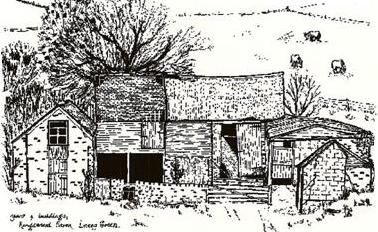
The last farmer to run the Farm as a unit was Allen-Armitage. This he did single-handed, working long hours, keeping a Jersey herd for milk production. At milking time classical music could be heard wafting from the milking parlour. Perhaps this was to help the drudgery of the task in hand, but it was also claimed the cows enjoyed the music and thus their yield was higher. Cultivation work would often take place in the evenings, when he would labour, working by headlights, late into the night on his tractor. In September 1963 the Farm was sold to R M. West and Son, of Stocken Farm, Lacey Green. They still retain the land and buildings, but subsequently sold off the Farmhouse as a private residence.
During the Spring and Summer of 2002 a trial excavation was made on land adjacent to 'Kiln Barn'. Reputedly, this was the first excavation of the Earthwork ever to have been undertaken in Buckinghamshire. The object of the exercise was to try and establish the possible course of Grim's Ditch.
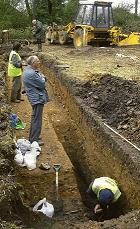
Towards the south-eastern boundary of the plot the Ditch was 'discovered', aligning roughly with the closest extant sections to the northeast.
The photograph to the left clearly illustrates the geological makeup of the Ditch. The dark strip of topsoil overlays a deep seam of clay, 'backfill' from the days when brick making was in operation here. A thin, but ever deepening, layer of 'flint rubble', running north-west to south-east, indicates the former lie of the Ditch. Below this level, in the foreground of the photograph, the black humus soil is a build up of sediment in the upper levels of the Ditch. Brick rubble in the foreground, beside the shovel, is further evidence of brick making activities.
The white carrier bags contain samples of timber excavated from the Ditch, waiting to be taken away for examination.
The main evaluation of the excavation is yet to be released, however, an interim report deals with the subject of pollen. A pollen sample, taken from the margins of the Ditch, was sent to the University of Southampton for analysis. The sample, gained from an auger hole at a depth of 1.71-1.77 metres in the fill of the Ditch, proved to be rich in well preserved pollen and spores. Sediment infilling can provide possible ideas on the date of the Ditch and the local environment.
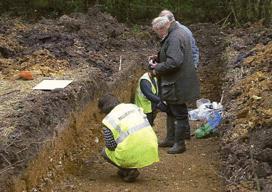

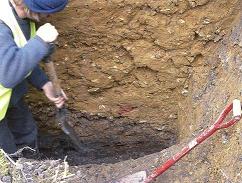
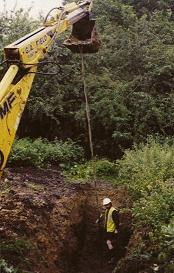
Evidence demonstrates that trees were an important feature of the landscape, dominated by oak, with traces of beech and holly. Birch, pine, poplar and alder, all wind pollinated, were well represented. Shrubs were dominated by hazel. It is likely that scrub woodland was growing in the proximity of the Ditch. The herb flora was diverse, but dominated by grasses, suggesting possible pastureland. A small number of cereal pollen grains indicate some arable activity may possibly have been taking place in the locality, but probably at some distance.
Some broad conclusions can be gained from this analysis, although pollen is not a tool for dating. The sequence, it is suggested, is of very late prehistoric or more probably early historic age. This suggestion cannot provide any indication of the original age of the Ditch, since the sample came from the upper levels of the fill and not from the base. The general importance of oak and hazel pollen noted is also commensurate with pollen data for the Iron Age, Roman and post Roman period.
This final chapter is, strictly speaking, not a subject connected with Kiln Lane, but has been added by request.
From Kingswood Farm the track now becomes Highwood Bottom (Some Ordnance Survey maps refer to it as Speen Bottom) continuing on towards the village of Speen. A belief appears to have arisen, in the days of the eighteenth century that all inhabitants of the Upper Hamlets (i.e. Speen, Lacey Green and Loosley Row) were extremely well endowed financially. This myth seems to have filtered through to the twenty-first century. Whilst it cannot be denied there are now some very wealthy residents in the three villages, it is equally true, sadly, that this wealth is not evenly distributed.
During the eighteenth century, the fact that the good people of Speen, carrying their heavy purses and bags of gold, were using this route to visit the 'Tesco's' of the day in Princes Risborough, was noted by a highwayman named Cooper. He figured that since most of this section of the ancient road, except for a small area on the south side, was bordered by woodland, it would be an ideal site to stage a 'hold-up'. He therefore began to 'work' this road with good results.
So successful were his exploits it is said at the time of his death he too had become a very wealthy man. It is claimed that he is buried, together with his vast treasure store, beside this road, the spot being marked by two large boulders. Some one hundred and fifty yards or so east of the entrance to Kingswood Farm, at the junction with Bridleway L30, these two large boulders remain and may still be seen in the hedgerow today. Reputedly, Cooper's ghost still haunts this valley on crisp, clear moonlight nights.
The foregoing is the Speen version of the story of the 'silent stones'. There is, of course, a far less romantic Lacey Green version.
It is believed there was once a lady named Nannie Cooper, who probably lived during the eighteenth century. She may have been connected with the management of Stocken Farm in Lacey Green, but this is uncertain. A rather eccentric person, it is said she would visit a pond to the south-east of Stocken Farm, taking with her a large bucket and a length of rope. Attaching the rope to the bough of an overhanging oak tree, she would climb into the bucket and swing back and forth across the surface of the water. Either by design or accident, but probably the former, she is said to have drowned in the pond. These boulders in Highwood Bottom reputedly mark her grave.
The very fact that the burial of those who committed suicide was not allowed in the consecrated ground of a Churchyard, may add some credence to the story. Prior to an Act of 1823 repealing the custom, the burying of suicides took place beside a public highway, possibly at cross roads, on the edge of the community. The boulders certainly stand on the borders of Speen and Lacey Green, in a setting that would have been remote and isolated in those far off days.
Other positive pieces of information have emerged regarding the Lacey Green version of the story. On an Abstract of Title of the aforementioned Sir William Foster, reference is made in 1766 to ' Cooper's Grave Bottom Wood'. This would suggest if the stones do mark a grave, that the burial was possibly around the middle of the 18th century.
Some years prior to the Princes Risborough Enclosure Act of 1823, the Commissioners surveyed the Parish of Princes Risborough and produced a map, which is still preserved, intact, in the County Record Office at Aylesbury. This particular section of the ancient highway between Speen and Princes Risborough is not recorded on the map as Highwood Bottom or Speen Bottom, but as 'Cooper's Grave Bottom'.
The field where the pond was situated is referred to as 'Cooper's Pond' on an old farm map, dated 1872. The pond disappeared within living memory, filled in during World War II, to make way for a wartime airfield for the use of Sir Arthur 'Bomber' Harris, Commander in Chief of Bomber Command at Walters Ash. Although the pond has vanished, 'Nannie Cooper's' is still retained as a present day field name.
The reader must therefore be left to draw their own conclusions from the above stories, but doubtless, the silent stones will keep their secret.
At 00.51 a.m. on Monday 23 September 2002 an earth tremor was recorded in England, centred on Dudley, in the West Midlands. The tremor, fairly large by British standards, measured 4.8 on the Richter Scale. Despite Dudley being some eighty miles from Lacey Green, the effects of the tremor were certainly felt in Kiln Lane. There was a very loud rumbling, reminiscent of the empty agricultural trailers that use the road from time to time. The violent shaking of buildings followed this, as if a bulldozer was carrying out a demolition. The whole sensation was over in a matter of seconds. Nevertheless, it was a rather strange and somewhat unnerving experience. Thankfully, no injuries or damage was sustained.
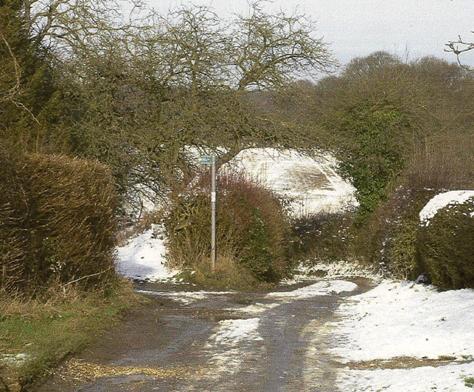
The Tarmac and Beyond presents a brief and very incomplete account of the history of Kiln Lane over the last two thousand years plus. Even a short work of this nature necessitates a great deal of research. Many aspects of the story, over so long a period, have been lost in the mists of time. Considering the relatively small area involved however, it is amazing how much information still survives from the past, some worthy of record, some best forgotten.
There have been four main sources of reference, namely:
My thanks to the Staff of the above for their help, also to those individuals who kindly allowed me access to their paperwork. Special thanks are due to the following, residents and non-residents alike, without whose help, assistance and encouragement this publication would not have been possible.
|
|